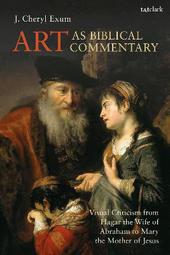
|
Art as Biblical Commentary: Visual Criticism from Hagar the Wife of Abraham to Mary the Mother of Jesus
Hardback
Main Details
| Title |
Art as Biblical Commentary: Visual Criticism from Hagar the Wife of Abraham to Mary the Mother of Jesus
|
| Authors and Contributors |
By (author) Professor J. Cheryl Exum
|
| Series | The Library of Hebrew Bible/Old Testament Studies |
|---|
| Physical Properties |
| Format:Hardback | | Pages:288 | | Dimensions(mm): Height 234,Width 156 |
|
| Category/Genre | Religious subjects depicted in art
Biblical studies |
|---|
| ISBN/Barcode |
9780567685186
|
| Classifications | Dewey:246 |
|---|
| Audience | | Tertiary Education (US: College) | |
|---|
| Illustrations |
91 colour illus
|
|
Publishing Details |
| Publisher |
Bloomsbury Publishing PLC
|
| Imprint |
T.& T.Clark Ltd
|
| Publication Date |
16 May 2019 |
| Publication Country |
United Kingdom
|
Description
Art as Biblical Commentary is not just about biblical art but, more importantly, about biblical exegesis and the contributions visual criticism as an exegetical tool can make to biblical exegesis and commentary. Using a range of texts and numerous images, J. Cheryl Exum asks what works of art can teach us about the biblical text. 'Visual criticism' is her term for an approach that addresses this question by focusing on the narrativity of images-reading them as if, like texts, they have a story to tell-and asking what light an image's 'story' can shed on the biblical narrator's story. In Part I, Exum elaborates on her approach and offers a personal testimony to the value of visual criticism. Part 2 examines in detail the story of Hagar in Genesis 16 and 21. Part 3 contains chapters on erotic looking and voyeuristic gazing in the stories of Bathsheba, Susanna, Joseph and Potiphar's wife and the Song of Songs; on the distribution of renown among Jael, Deborah and Barak; on the Bible's notorious women, Eve and Delilah; and on the sacrificed female body in the stories of the Levite's wife (Judges 19) and Mary the mother of Jesus.
Author Biography
J. Cheryl Exum is Emeritus Professor of Biblical Studies at the University of Sheffield, UK.
ReviewsWhether you already have a great knowledge of the Bible and/or art history, or neither of these subjects, you could not fail to be instantly drawn into the brilliance of Exum's work such is the skill of her writing in presenting absorbing, challenging arguments about what is actually happening in the relationship in and between a biblical text and the greater and lesser known "masterpieces" of Western-European art that have attempted to interpret and depict these narratives over the past four or five centuries. * Reading Religion * In yet another thought-provoking and challenging volume, Cheryl Exum explores several gems from the repertoire of Western art to reflect on what is said - but more often left unsaid - in the biblical text. With meticulous attention to the detail of the paintings, she conveys with freshness, originality and wit how an artist can capture that very precise nuance of a text, or that exact trait of a character, that so often eludes traditional commentators. Through a judicious selection of artists and paintings, Exum skilfully and persuasively shows us that there are many ways of "seeing" and appropriating biblical stories. Most importantly, Exum has successfully championed an approach that is useful for everyone who values the artist's essential role in biblical interpretation. * Martin O'Kane, University of Wales Trinity Saint David, UK * Art as Biblical Commentary takes an increasingly popular branch of Biblical Studies to new levels, exegetically and methodologically, showing over and over again, for the benefit of ordinary readers as well as experts, what valuable, nuanced insights into the meaning of the Bible can be revealed by a careful study of works of art like a seventeenth-century Dutch Jael, Deborah and Barak, two nineteenth-century paintings of Eve and Delilah and a twentieth-century Blinded Samson. * John F. A. Sawyer, University of Edinburgh, UK * A conversation between ancient texts, early modern visual responses, and contemporary teachers and their students is the most effective way to keep the past alive on behalf of today and tomorrow. Rather than the hopeless endeavour of reconstructing the past "as it was" Exum helps us talk with the past "as it is". And in the process, she demonstrates that one can talk with images as much as with words. This is interdisciplinary cultural analysis at its best. * Mieke Bal, Cultural Theorist and video artist, University of Amsterdam, The Netherlands * The book shows great interest for all those who want to approach another way of looking at the biblical text, to approach from another perspective, for those who want to find new details that help them meditate, contemplate the message of God to the men and women of today. * Archivo Teologico Granadino (Bloomsbury Translation) *
|